The Danxia landform refers to various landscapes found in southeast, southwest and northwest China that "consist of a red bed characterized by steep cliffs".
It is a unique type of petrographic geomorphology found in China. Danxia landform is formed from red-coloured sandstones and conglomerates of largely Cretaceous age. The landforms look very much like karst topography that forms in areas underlain by limestones, but since the rocks that form danxia are sandstones and conglomerates, they have been called "pseudo-karst" landforms. They were formed by endogenous forces (including uplift) and exogenous forces (including weathering and erosion).
China Danxia is the name given in China to landscapes developed on continental red terrigenous sedimentary beds influenced by endogenous forces (including uplift) and exogenous forces (including weathering and erosion). The inscribed site comprises six areas found in the sub-tropical zone of south-west China. They are characterized by spectacular red cliffs and a range of erosional landforms, including dramatic natural pillars, towers, ravines, valleys and waterfalls. These rugged landscapes have helped to conserve sub-tropical broad-leaved evergreen forests, and host many species of flora and fauna, about 400 of which are considered rare or threatened.
The first studies on what are now referred to as Danxia landforms were conducted at Mount Danxia near Shaoguan, China. In the 1920s and 1930s Chinese geologists made an effort to learn more about these interesting geomorphic structures. Danxia landforms are made up of uplifted continental crust that has been faulted and eroded, exposing large scarps of layered rock, red in color.
Geologists believe that Danxia topography is formed as a result of movement in the earth’s crust. This makes rock layers appear in different colors, textures, shapes, sizes, and patterns. The combination of differences in density and erosion creates towering peaks, cave holes and stone halls.
Danxia formations are green, yellow, blue and many other colors, though their appellation comes from the red rocks of Mount Danxia in Guangdong. Experts say that they are the result of red sandstone and other rocks undergoing metamorphic processes for millions of years.
China Danxia is a serial property comprising six component parts (Chishui, Taining, Langshan, Danxiashan, Longhushan, and Jianglangshan) found in the sub-tropical zone of south-eastern China within approximately 1700 km crescent shaped arc from Guizhou Province in the west to Zhejiang Province in the east.
Due to the combined endogenic (tectonic uplift) and exogenic (climatic, erosion, weathering) forces, and other factors, the Danxia landforms have been developed in red sedimentary sequences continuously from the Neogene until the present. The six component parts represent the most important examples of "least eroded" to "most eroded" Danxia landforms, providing a range of different aspects of the phenomenon, and illustrate both the range of landforms in relation to the forces and processes that formed them, together with a range of associated landscapes.
The Zhangye Danxia landform is also known as the eye candy of Zhangye. Many artists admire this masterpiece as it appears like a perfect painting on canvas. This 400-square-kilometer attraction is located in in Linze and Sunan counties in Gansu Province in central north China.
The Guardian featured Zhangye's Danxia Landforms in pictures, and called this fantastic landscape: "China's rainbow mountains".


